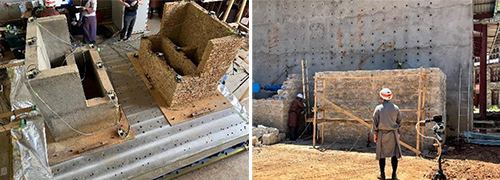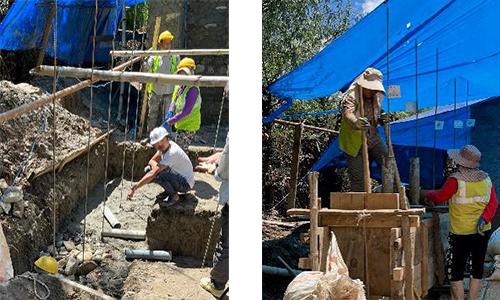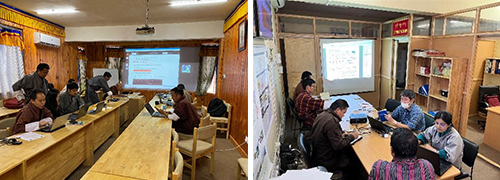Project News
2022-08-31
Monthly Report for August 2022
Conducted shaking table tests and U-shaped wall static loading tests
On August 11th and 12th, the Department of Culture (DOC), Ministry of Home and Cultural Affairs (MoHCA) and the Department of Engineering Services (DES), Ministry of Works and Human Settlement (MoWHS) conducted shaking table experiments at DOC yard. Japanese researchers visited Bhutan for the first time in about 2 years and 9 months and vibrated the standby specimens (1/6 scale model). The specimens are two (2) rammed earth structures (with/without reinforcement) and 2 mud-mortar masonry structures (with/without reinforcement).
Although the counterparts had been taught how to operate the shaking table through remote training, this time they learned how to set the specimens, the measuring equipment, use the measurement software, and apply vibration load. The reinforcement effect can be clearly confirmed by placing of two specimens - the "unreinforced building" and the "reinforced building" on the shaking table and vibrating them at the same time.
For the first vibration, the Japanese team gave detailed guidance on the entire process from preparation to measurement, and for the second vibration, the Bhutanese team did them by themselves. The Japanese team will also travel to Bhutan in September and conduct experiments by changing the direction of the specimens (rotating 90 degrees) to confirm changes in the behaviour of the building depending on the direction of shaking.
Shaking table tests using scaled-down model specimens are expected to become mainstream in the future, as they are less expensive to construct than full-scale specimens.
On August 16th and 17th, static loading tests were conducted on U-shaped specimens (3/4 scale model). These test specimens have structure in which ‘Through stones', which have the equal length of wall thickness, are placed at "wall corners" and "flat wall at regular intervals (every 1 square meter)". Through stone is expected to have the effect of controlling shear cracks (preventing diagonal cracks). A wall with through-stones and a wall without through-stones were pressed with a hydraulic jack to measure their strength. As a result, although no increase in yield strength was observed, there was a difference in fracture properties (how it broke). In the future, Project plans to make a scaled-down model of through- stone and verify it on a shaking table.
 Shaking of rammed earth test specimen (left),
Static loading of the U-shaped specimen (right)
Shaking of rammed earth test specimen (left),
Static loading of the U-shaped specimen (right)
Photo provided by DOC
For teaching materials, video recording of construction procedure at the Department of Culture (Using an F-shaped wall construction)
Under the supervision of Japanese researcher, construction guidance using an F-shaped wall mock-up specimens was carried out at the Department of Culture (DOC). They are specimens that imitates both rammed earth and stone masonry, and have a foundation, underground beams, walls, columns and beams.
The seismic resistance construction method the project developed, and the updated construction standards are also applied in the construction of these specimens. The purpose is to record the key points of these constructions and create a teaching video. The video teaching materials created will be used in the Training of Trainers (trainer training) conducted for the Dzongkhag engineers. Under the guidance of researchers, the builder carefully constructed each part, and the key points were recorded.
In addition, seismic reinforcement with metal mesh and mortar was also performed on the walls, and the construction process was recorded. There are many points to check, such as confirming the fixing length of the reinforcing bars in the concrete and the thickness of the covering concrete. This video is made by focusing on the important points that are often overlooked in the familiar construction.
 JP researcher supervising construction process (left),
Ramming process of construction (right)
JP researcher supervising construction process (left),
Ramming process of construction (right)
Photo provided by DOC
Operation training of seismic observation software (Seiscomp) at the Department of Geology and Mines
From August 15th (duration 7 days), operation training of the seismic observation software "Seiscomp" was held at the Department of Geology and Mines (DGM). Basing on a style receiving remote guidance from a training firm, Japanese researcher - Professor Ohmi of Kyoto University visited Bhutan to support the training and help the Bhutan team learn. By introducing this software, DGM will be able to observe earthquakes with a magnitude (M) of less than 3 (previously it was only possible to observe earthquakes of M3 or higher).
In addition, the professor modified the server system so that DGM can approach and analyse the data from 14 seismic stations on their own computers with this software. At the last day of the program, the professor had his closing meeting and explained what status DGM server is, and he advised for questions from DGM members, how to configurate data sending from the observation stations.
 Training of software (left),
Closing meeting before JP researcher leave (right)
Training of software (left),
Closing meeting before JP researcher leave (right)
Photo provided by Prof. Ohmi
- About JICA
- News & Features
- Countries & Regions
- Our Work
- Thematic Issues
- Types of Assistance
- Partnerships with Other Development Partners
- Climate Change / Environmental and Social Considerations
- Evaluations
- Compliance and Anti-corruption
- Science and Technology Cooperation on Global Issues
- Research
- JICA Development Studies Program / JICA Chair
- Support for the Acceptance of Foreign HRs / Multicultural and Inclusive Community
- Publications
- Investor Relations
